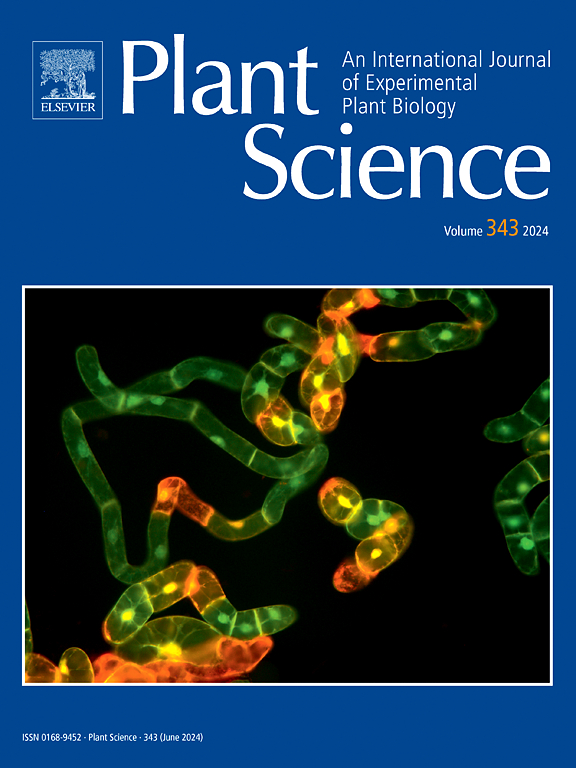Cytoprotective role of pyruvate in mitigating abiotic stress response in Arabidopsis thaliana
IF 4.2
2区 生物学
Q2 BIOCHEMISTRY & MOLECULAR BIOLOGY
引用次数: 0
Abstract
Pyruvate is a central metabolite in cellular respiration and metabolism. It can neutralize reactive oxygen species (ROS), safeguard mitochondrial membrane potential, and regulate gene expression under oxidative stress. However, its role in abiotic stress tolerance in plants needs to be explored. Therefore, the current study investigated the role of pyruvate and its metabolism in response to different abiotic stresses in the model plant Arabidopsis thaliana. We retrieved transcript profiling data for pyruvate metabolism and transportation genes (D-LDH, AlaAT, PK, MPC, PDC, PDH, NAD-ME) from public databases. The study’s findings indicate that these genes’ expression is regulated in response to different abiotic stresses. Moreover, the promoter region of these genes contained multiple cis-acting elements like ABRE, ARE, P-box, and MBS, which are associated with plants' abiotic stress response. Furthermore, colorimetric analysis showed higher pyruvate content under different abiotic stresses. Therefore, exogenous pyruvate treatment was given before and after different abiotic stresses, which could combat the toxicity of pro-oxidant molecules by pyruvate intake. The semiquantitative RT-PCR analysis revealed that exogenous pyruvate treatment enhances the expression of important transcription factors WRKY2, GH3.3, DREB2A, and bZIP1, and stress-responsive genes e.g., APX1, ERD5, ADC2, and HSP70 in addition to abiotic stresses. Moreover, Arabidopsis plants pre-treated with pyruvate before oxidative stress showed less RBOHD expression. Additionally, pyruvate's cytoprotective role was compared to other well-known antioxidants such as NAC, Trolox, and GSH. Finally, untargeted GC-MS/MS analysis of abiotic stress-treated Arabidopsis plants showed a higher metabolite level of β-hydroxy-pyruvic acid, indicating the crucial role of pyruvate during abiotic stress.
丙酮酸在减轻拟南芥非生物胁迫反应中的细胞保护作用。
丙酮酸是细胞呼吸和代谢的中心代谢物。它可以中和活性氧(ROS),保护线粒体膜电位,调节氧化应激下的基因表达。然而,其在植物非生物逆境抗性中的作用有待进一步研究。因此,本研究对拟南芥中丙酮酸及其代谢在不同非生物胁迫下的作用进行了研究。我们从公共数据库中检索了丙酮酸代谢和运输基因(D-LDH, AlaAT, PK, MPC, PDC, PDH, ad - me)的转录谱分析数据。研究结果表明,这些基因的表达在不同的非生物胁迫下受到调节。此外,这些基因的启动子区域包含ABRE、ARE、P-box、MBS等多个顺式作用元件,这些元件与植物的非生物胁迫反应有关。比色分析表明,在不同的非生物胁迫下,丙酮酸含量较高。因此,在不同的非生物胁迫前后给予外源性丙酮酸处理,可以通过摄入丙酮酸来对抗促氧化分子的毒性。半定量RT-PCR分析显示,外源丙酮酸处理增加了重要转录因子WRKY2、GH3.3、DREB2A和bZIP1的表达,以及应激反应基因APX1、ERD5、ADC2和HSP70的表达。此外,氧化胁迫前经丙酮酸预处理的拟南芥植株RBOHD表达量较低。此外,丙酮酸的细胞保护作用与其他众所周知的抗氧化剂如NAC、Trolox和GSH进行了比较。最后,非生物胁迫处理的拟南芥植株的非靶向GC-MS/MS分析显示,β-羟基丙酮酸代谢产物水平较高,表明丙酮酸在非生物胁迫过程中起着至关重要的作用。
本文章由计算机程序翻译,如有差异,请以英文原文为准。
求助全文
约1分钟内获得全文
求助全文
来源期刊

Plant Science
生物-生化与分子生物学
CiteScore
9.10
自引率
1.90%
发文量
322
审稿时长
33 days
期刊介绍:
Plant Science will publish in the minimum of time, research manuscripts as well as commissioned reviews and commentaries recommended by its referees in all areas of experimental plant biology with emphasis in the broad areas of genomics, proteomics, biochemistry (including enzymology), physiology, cell biology, development, genetics, functional plant breeding, systems biology and the interaction of plants with the environment.
Manuscripts for full consideration should be written concisely and essentially as a final report. The main criterion for publication is that the manuscript must contain original and significant insights that lead to a better understanding of fundamental plant biology. Papers centering on plant cell culture should be of interest to a wide audience and methods employed result in a substantial improvement over existing established techniques and approaches. Methods papers are welcome only when the technique(s) described is novel or provides a major advancement of established protocols.
 求助内容:
求助内容: 应助结果提醒方式:
应助结果提醒方式:


